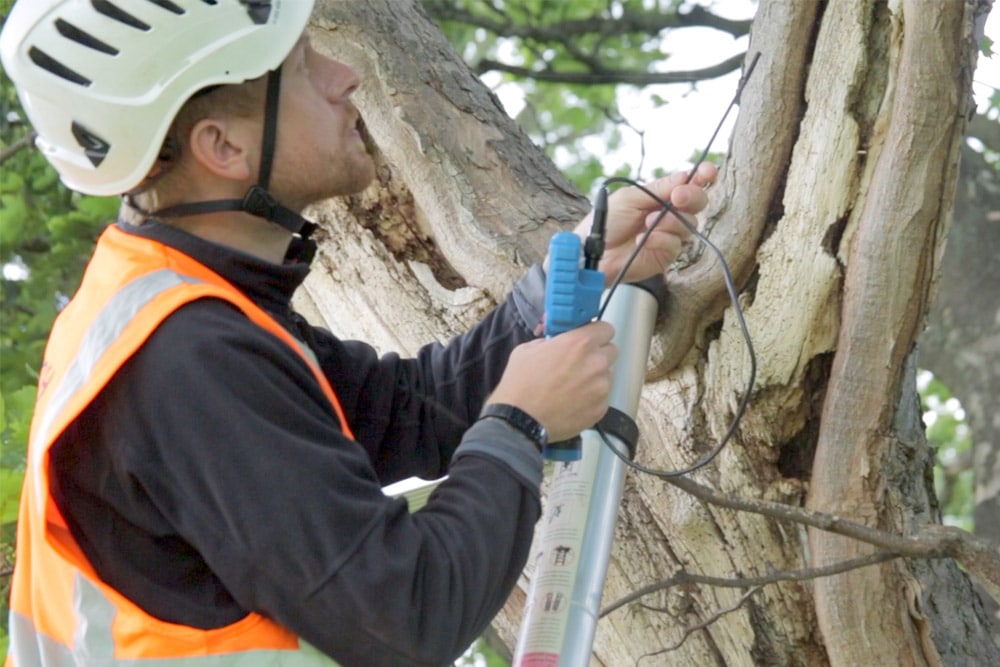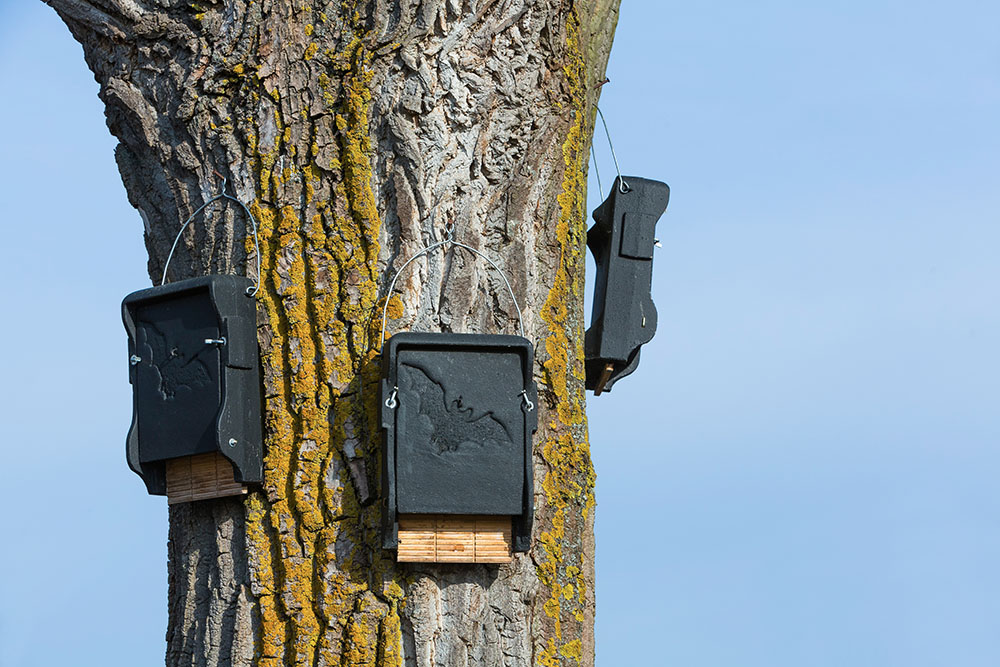Learn More About Bat Emergence Surveys

The decline in bat populations across the 18 native species of bat found in the country over the last 50-100 years has been linked to the advance in the footprint of our towns and cities and the subsequent loss of high-quality bat roosting and feeding habitat throughout the UK.
In response to this, the government has transposed the EU Habitats Directive in the UK through the Conservation of Habitats and Species Regulations 2010, effectively criminalising the disturbance of individual bats and their habitat.
This doesn’t mean that the evidence of bats or their habitats on your site can stop you from obtaining a planning application or that bats can immediately and indefinitely ruin your project. It does, however, mean that your local planning authority will need to see proof that you can provide mitigation work appropriate to the species of bats, population and roost type, or undertake development proposals in a way to avoid bats and any process that could intentionally kill, injure or endanger bats if evidence of bats is found on the site.
Bat surveys fulfil this obligation, starting with a Preliminary Roost Assessment (PRA) / Scoping Bat Survey before moving onto Bat Emergence Surveys (BERS). A BERS is a secondary form of bat survey that enables a licensed ecologist to use specialist equipment such as bat detectors to gather more detail on bats flying to and from each individual bat roost across clear flying spaces and flight paths. It would be necessary to book a BERS if it has been established that void dwelling or crevice dwelling bats are present, or even if bats haven’t been confirmed but the site has enough habitat value for bats to roost.
What is a Bat Emergence Survey?
Following the completion of a Preliminary Roost Assessment (PRA) / stage one survey to find bats and determine the scale of the presence of bats on a property or site, a Bat Emergence and Re-Entry Survey (BERS) is stage two in the initial bat survey process.
As such, the results of a stage 1 survey – i.e. evidence of bats being present such as identification of bat droppings, the feeding remains of prey, living or dead bats, or potential roosting features (e.g. hanging tiles, missing roof tiles, weatherboarding or a large roof area that could pose high potential for crevice dwelling species such as roosting bats) – will gauge whether or not a BERS is needed.
Once it is established that a BERS survey is necessary, an ecologist will visit the site and monitor the entry and exit points to gather information on the UK bat species, location and population. The data gathered from this exercise will be used to gauge the presence of bats on the site as well as the effect bats may experience as a result of the permitted development work.
A suitably qualified ecologist will analyse the site or property at length and record bats, both in terms of the visual and sound of inhabiting bats, before compiling their findings and effective recommendations into a BERS report that can then be submitted to the local council as part of the application for planning permission.
With the purpose of supporting bats and planning applications on small or large plots of land and – in some cases – multiple sites at a time, a physical inspection of this nature could involve several bat ecologists in order to fully undertake an internal and external inspection of the site.
Why do you need a Bat Emergence Survey?
Under the Wildlife and Countryside Act 1981 and the Conservation of Habitats and Species Regulations 2017, bats are fully protected alongside other European protected species, both domestically and internationally.
Over the course of any project that could interfere with or endanger inhabiting or roosting bats such as building, extending or demolishing properties, producing wind turbines, barn conversions, and hedgerow or tree removal, the local planning authority will need proof that rules are being followed to avoid disturbing bats as a result of human activity, creating reduced roosting space or causing unnecessary harm to nearby bat species.
In a stage 2 bat survey, a qualified ecologist will record data in regards to the type of species on the site or property, entry and exit points that could indicate locations of habitats, and estimate the potentially big or small number of bats present. The bat roost status is also an important factor as the type of bat roost can indicate a different purpose, with an existing building or tree commonly featuring locations with moderate or high suitability where bats roost.
For instance, common examples of bat roosts include day roosts, night roosts, hibernation roosts, maternity roosts and transitional roosts. Using this information, an ecologist can form an understanding of the specific bat habitats on the site and, alongside the proposed development plans and using the necessary bat licence, develop a mitigation strategy of mitigation and compensation measures that will enable the project to go ahead despite the presence of bats.
The ecologist’s recommendations will then be put forward to the local authority to support the developer’s planning application. If the local authorities then decide to grant a full planning application as a result of the ecologist’s report, the developer will be eligible to make the necessary bat survey licence applications – often a low-impact bat mitigation licence – enabling them to make alterations based on the predetermined mitigation measures.
Additionally, the local authority will have separate reasons for requiring this type of more detailed assessment. Primarily, a local council will need a BERS report as it caters to two primary factors:
- Remaining within the rules of legislation that protects European protected species such as roosting bats by monitoring bat activity and reducing unnecessary disturbance
- Supporting the state of local biodiversity, both in terms of short-term impacts and long-term impacts.
A method of ticking off catering to both of these considerations is through using further bat surveys to find evidence of bats early on, utilising a vast array of state-of-the-art technology such as bat detectors and DNA testing equipment, determining roosting features that could serve as suitable habitats for future species, mitigating against potential stumbling blocks in the planning process, and remaining in line with the expert guidance and support of the Bat Conservation Trust, Natural England, Natural Resources Wales and the Chartered Institute of Ecology and Environmental Management (CIEEM).
Bat Emergence Survey Season
As with any legally protected species surveys, bats are protected under certain national and European legislation, and restrictions are in place as a legal requirement based on the specific bat activity, behaviours and hibernation patterns of the species in question. Due to this approach, the bat survey season takes place outside of bat hibernation, as that will be the best time to confirm the presence of absence of bats.
Bats hibernate between November and March, meaning that it is only possible to carry out BERS at a certain time of the year between the months of April and October. However, the optimal period lies in the summer months between May and September, with at least one survey visit taking place in the peak of activity between May and August. The BCT publication ‘Bat Surveys for Professional Ecologists Guidelines – Good Practice Guidelines’ insists that Emergence Surveys are solely conducted within this time of the year.
Bat Emergence Survey Guidelines
Within full bat survey guidelines from the BCT and rules enforcing legal compliance, Emergence / Re-Entry Surveys must be conducted outside of daylight hours and solely around sunrise and sunset. More specifically, stage two surveys on nocturnal animals such as bats are undertaken 15 minutes before or two hours after sunset, or two hours before or 15 minutes after sunrise.
For this reason, Bat Emergence and Re-Entry Surveys are often also called Dusk and Dawn Surveys, Dusk and Dawn Re-Entry Surveys or Dawn and Dusk Emergence Surveys. Elsewhere, they may also be referred to as Bat Activity Surveys and Activity Bat Surveys.
Ecological consultants will monitor important areas such as suspected resting places, foraging areas, feeding roosts, and trees or buildings close to the site during several visits over numerous occasions until sufficient data on bat species, access points, roosting locations and roosting features has been collected.
The number of bat consultants required for the BERS and other factors will be determined by the results of Preliminary Roost Assessments (PRA) / a Bat Scoping Survey carried out beforehand. The PRA will also influence the number of visits to the site for an Emergence Survey, with the size of the site and the low or high suitability for bat roosts acting as the deciding factor on whether one, two or three surveys are required. Not only will this help to fully cover the area, but it will also ensure that every bat species has been accounted for, particularly if there is an extensive number.
Best Equipment for Recording Bat Emergence
Although the work methods and approach for Bat Activity Surveys may vary depending on the expert opinion of the experienced ecologists carrying out the impact assessment, it often involves the same sorts of ecological survey equipment.
Examples of this include bat detectors, infrared, night vision and thermal imaging cameras to see the present species of bat, and voice recorders that convert the bats’ echolocation calls into a tangible frequency readout.
As each species has a different type of bat call, the ecologist can use this information as a secondary method of determining certain species. In some situations, it may also benefit the survey process to incorporate radio tagging and DNA analysis.
Bat Mitigation
During the course of Activity Surveys, if you find a bat present on your property or site using it as a roost or even merely suspect bat occupancy, the focus is on collecting and indexing three primary types of data:
- The species of bat present
- The populations of bat present
- The purpose of the site from the bat’s perspective
Once the collected data has answered these three questions, the results will dictate the mitigation measures in the survey report, and the chosen approach will vary significantly based on certain circumstances. A single male soprano pipistrelle bat (Pipistrellus pygmaeus) using your barn as a transitionary summer roost, for example, will require very different mitigation measures to a maternity colony of the ultra-rare Barbastelle bats (Barbastella barbastellus).
Fortunately, each licensed ecologist in our ranks possesses the necessary ties to Natural England and Natural Resources Wales to support an application for a mitigation licence. With it, you will be able to implement effective changes that will support bats while guaranteeing that the ecologist’s recommendations don’t obstruct access on the development site for the proposed work to go ahead as planned and not impact bats.
What is Bat Mitigation?
The creation of a mitigation plan is a simple process that revolves around preventing a loss of habitat and maintaining natural habitats present on the site. In the months between November and March, bats undergo a period of hibernation – a biological change that coincides with a drop in metabolism, a reduced heartbeat, consistently regulated temperature, and utilisation of fats already in their system from past months.
Known as torpor, hibernation is a form of suspended animation that will affect bats, leaving them extremely sensitive to disruption. So much so, in fact, that if someone were to disturb bat roosts during hibernation, it could harm bats or even kill them.
As a result, implementing appropriate mitigation measures from the perspective of an ecologist with a bat mitigation class licence is often preferred outside of hibernation season. However, the restriction on time limits 12 months down to seven, potentially causing costly delays to developers that need their new development to progress straight away.
Eliminating this issue is simply impossible, but you can plan ahead by booking a Bat Emergence and Re-Entry Survey with us as early as possible so we can arrange a visit to your site at the next available opportunity. The alternative would be to book at short notice, leading to the reasonable likelihood of being unable to arrange a suitable date for determining bat presence.
Mitigation Measures: Examples
It is easy to assume that mitigation measures will be comprehensive, complicated and costly, but in fact, they are often easy to implement and relatively cheap. In far from rare cases of a single common pipistrelle (Pipistrellus pipistrellus), for instance, mitigation could be as simple as installing some bat boxes on your site as an alternative bat roosting location.
Likewise, it could be just as effective to make use of innovative building products, like ‘bat access tiles’ that can be installed in a way that appeases inhabiting bats without making your property look unsightly. Alternatively, however, mitigation for bats can be far more complex. Larger species of bats protected by corresponding legislation, like brown long-eared bats (Plecotus auritus), for instance, are not crevice dwellers like their pipistrelle cousins.
Instead, they require a void to make short flights that prepare their body for the strenuous nature of hunting flying insects and need to elevate their heart rate and pump some blood into their wings before emerging from existing roosts they’re flying from or new roosts they’re flying to.
A suitable void can quite easily be a section of your roof void or loft space partitioned off. That said, if it presents an issue, such as if you are planning a loft conversion, then other solutions that would better fit your development plans may need to be considered, such as the example below:
Bat Emergence Survey Cost
Due to the fact that they involve multiple visits to the site, at night, during certain periods in the year and involving more than one bat surveyor to cover numerous angles, an Emergence Survey is more expensive than a Scoping Bat Survey and other legally protected species surveys. On estimate, a BERS consisting of two to three days’ professional bat work will cost in the region of £789+VAT.
The specific circumstances of your site and project will, however, affect the number of visits and professional ecologists required to conduct the assessment. For an accurate quote, it would be advisable to contact us, and our team can give you a price that reflects the direct specifications of your project and the moves needed to support an application for planning consent.
Our Bat Team
With over a decade of relevant experience carrying out Bat Emergence and Re-Entry Surveys and other bat assessments, our ecological consultancy services are managed by a team of experienced and qualified bat surveyors who are situated across the country, making it possible to visit your site regardless of where you are based.
With a thorough understanding of ecological surveys, active habitat regulations, the latest standards and current good practice guidelines, and the new bat survey guidelines from the Bat Conservation Trust, each ecology consultant is registered in England and equipped to provide expert advice and the necessary steps for further action.
It is important to note that our expert ecologists cannot override professional judgment or replace the experience of other key stakeholders. But they are effective in conducting bat surveys to a high standard, and they can also comprehensively analyse both the project and the site to consider whether further surveys are required.
Book a Bat Emergence Survey Today
If you need a bat survey or maybe even need more convincing that your project would be in good hands with us, simply check out our feedback and see the seemingly endless array of five-star reviews sent in from our large network of happy clients, past and present. You also don’t need to feel compelled to commit until you are satisfied with the excellent service we offer, as we will provide you with a free quote based on details of your site and project.
You can then mull over your quote, and if you decide to go ahead, simply get in touch with us to confirm that you wish to move forward with the process and we will be able to work with you to arrange a suitable date and time to visit your site and carry out the initial assessment, often regardless of weather conditions.
Once the survey is complete, you will receive a comprehensive bat survey report a few days later. With it and other bat survey services you may need, we will be able to support roosting bats on your development site and account for any considerations that will help your application for planning permission put forward to the local planning authority.




